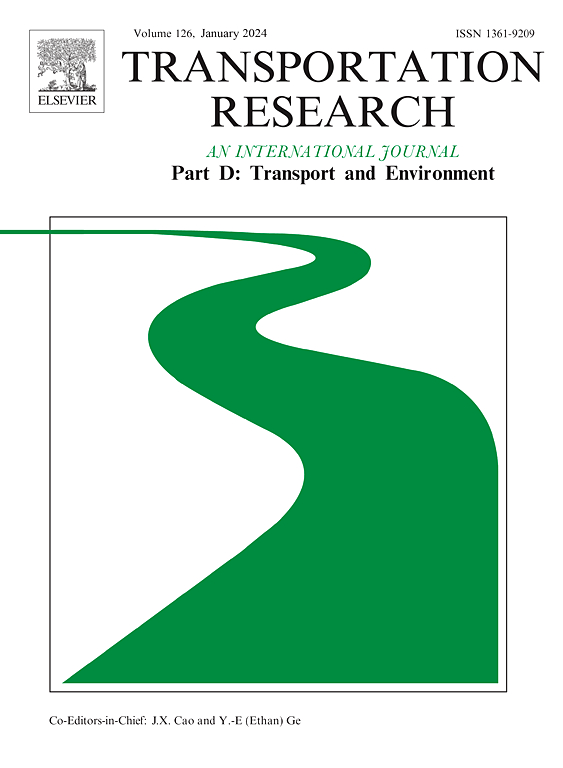Carbon savings in ride-pooling: A data-driven, route-based analysis from East Asia
IF 7.3
1区 工程技术
Q1 ENVIRONMENTAL STUDIES
Transportation Research Part D-transport and Environment
Pub Date : 2025-04-25
DOI:10.1016/j.trd.2025.104764
引用次数: 0
Abstract
Ride-pooling characteristics, especially its routes’ characteristics have rarely been studied in the context of carbon emission reduction. This study proposes a route classification system and develops a refined version of the MOVES model, incorporating data from the Amap API. The model accounts for speed distribution, road hierarchy, and vehicle type to assess the impact of ride-pooling on carbon emissions in Suzhou, China. The results indicate that only 3.5 % of ride-hailing trips are pooled, mainly within the 5–15 km range, achieving a 22.54 % carbon reduction compared to non-pooled trips. The “overlapping route with all passengers” type achieves the highest reduction of 44.73 %. Compared to hybrid and electric vehicles, fuel-powered vehicles exhibit significantly higher emissions, with potential carbon savings of up to 8000 g per trip on longer routes when ride-pooling is implemented. Full ride-pooling adoption could cut Suzhou’s annual emissions by 30,000 tons, equivalent to a 19.14 % reduction in total ride-hailing emissions. These findings highlight the critical role of promoting ride-pooling and optimizing long-distance, high-overlap routes to maximize carbon reductions.
拼车的碳节约:来自东亚的数据驱动、基于路线的分析
在碳减排的背景下,拼车的特征,尤其是其路线特征的研究很少。本研究提出了一种路线分类系统,并结合高德地图API的数据,开发了MOVES模型的改进版本。该模型考虑了速度分布、道路等级和车辆类型,以评估拼车对苏州碳排放的影响。结果表明,只有3.5%的网约车出行是拼车出行,主要在5-15公里范围内,与非拼车出行相比,碳排放量减少了22.54%。“全员重叠航线”降幅最大,达44.73%。与混合动力汽车和电动汽车相比,燃油动力汽车的排放量要高得多,在实施拼车的情况下,在较长的路线上,每趟行驶可节省高达8000克的碳排放。全面采用拼车可以使苏州的年排放量减少3万吨,相当于乘车总排放量减少19.14%。这些发现强调了促进拼车和优化长距离、高重叠路线以最大限度地减少碳排放的关键作用。
本文章由计算机程序翻译,如有差异,请以英文原文为准。
求助全文
约1分钟内获得全文
求助全文
来源期刊
CiteScore
14.40
自引率
9.20%
发文量
314
审稿时长
39 days
期刊介绍:
Transportation Research Part D: Transport and Environment focuses on original research exploring the environmental impacts of transportation, policy responses to these impacts, and their implications for transportation system design, planning, and management. The journal comprehensively covers the interaction between transportation and the environment, ranging from local effects on specific geographical areas to global implications such as natural resource depletion and atmospheric pollution.
We welcome research papers across all transportation modes, including maritime, air, and land transportation, assessing their environmental impacts broadly. Papers addressing both mobile aspects and transportation infrastructure are considered. The journal prioritizes empirical findings and policy responses of regulatory, planning, technical, or fiscal nature. Articles are policy-driven, accessible, and applicable to readers from diverse disciplines, emphasizing relevance and practicality. We encourage interdisciplinary submissions and welcome contributions from economically developing and advanced countries alike, reflecting our international orientation.

 求助内容:
求助内容: 应助结果提醒方式:
应助结果提醒方式:


